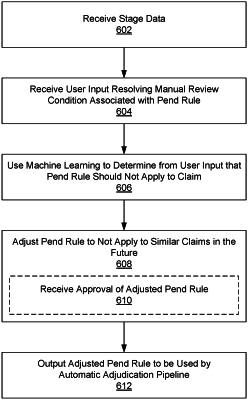| CPC G06Q 40/08 (2013.01) [G06N 5/025 (2013.01); G06N 20/00 (2019.01); G06Q 10/10 (2013.01); G06Q 50/182 (2013.01)] | 20 Claims |

|
1. A computer-implemented method, comprising:
receiving claim data, associated with a claim, that identifies one or more services rendered by an entity for a plan participant covered by a benefit plan;
processing the claim data with an automatic adjudication pipeline comprising a plurality of modular stages, wherein:
the automatic adjudication pipeline is configured to use a plurality of pipeline rules to automatically adjudicate the claim,
different modular stages, of the plurality of modular stages, are associated with different subsets of the plurality of pipeline rules, and
one or more modular stages, of the plurality of modular stages, are configured to operate at least in part on output data generated by one or more preceding modular stages in the automatic adjudication pipeline during automatic adjudication of the claim;
determining that a manual review condition, defined by a pend rule of the plurality of pipeline rules, at least temporarily prevents the automatic adjudication pipeline from automatically adjudicating the claim;
redirecting, based on the manual review condition, adjudication of the claim from the automatic adjudication pipeline to a user interface for manual review of the claim, wherein the user interface is configured to display at least a portion of the claim data associated with the manual review condition;
receiving, via the user interface, user input indicating a resolution of the manual review condition in association with the claim;
adjusting the plurality of pipeline rules by training a machine learning model based on the resolution of the manual review condition, indicated by the user input, wherein the training of the machine learning model:
causes at least one pipeline rule, of the plurality of pipeline rules, to automatically apply the resolution of the manual review condition during automatic processing of subsequent claim data associated with at least one claim in a set of subsequent claims, and
reduces a number of claims, in the set of subsequent claims, that are redirected from the automatic adjudication pipeline to the user interface for manual review based on the manual review condition; and
processing one or more portions of the claim data with the automatic adjudication pipeline, based at least in part on the user input.
|